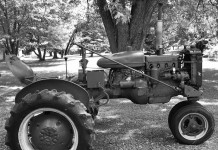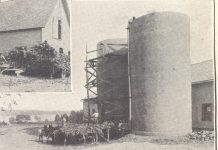The state of agriculture in this country was still quite primitive in 1840, but many farmers were beginning to realize the farming practices of their fathers and grandfathers were long past their use-by-date. These progressive agriculturists were hungry to learn new ways of doing things and, to feed this hunger, there was a huge growth in weekly and monthly farm publications during the two or three decades prior to the Civil War.
One of these, The Cultivator, was published in Albany, New York by Luther Tucker and printed each month on the “Steam-Press ofe. Van Benthuysen” (a subscription cost $1 per year for 12 issues).
Newspaper
In my collection I happen to have bound volumes of The Cultivator for the years 1840 and 1841. These old papers are fascinating to me, although some of the terms used are hard to figure out, and the sheer wordiness of our ancestors amazes me.
A large part of the content of each issue of The Cultivator is made up of letters from readers, offering their observations on things they’ve seen, advice on how things should be done and, of course, criticism of the letters published in earlier issues. And those old boys wrote long letters! When one realizes that they were probably scratched out by candle light, with a quill pen that had to be continually dipped into ink, it’s incredible that they wrote so much.
There aren’t a lot of advertisements in The Cultivator, and most of those that do appear don’t include prices. A few, however, do list the cost of the items offered for sale and they may prove interesting to Farm and Dairy readers.
Classifieds
A. B. Allen from Buffalo, N.Y., offered Berkshire and China pigs “… got by the choicest imported boars out of select sows.” The price was, ” … for Berkshires, two months old, boxed and delivered on steam-boat in Buffalo, or canal boat, per pair, $20. Chinas, $15. Older pigs and very select, will come at higher prices.” A competitor offered ” … genuine Berkshire pigs eight weeks old. Price $12 per pair, delivered on board of any vessel in New York, free of charge.
For $20, in Utica, N.Y., one could buy a “Grime’s Patent Smut Machine,” that was tested by the New York Agricultural Society. This august body found (according to J. Durkee, the machine’s inventor) ” … its performance upon a very smutty quality of wheat,” that was ” … unsaleable in any market …” to render that wheat ” … pure and clean.”
A nursery advertised “3,000 Peach trees, of thrifty growth, at 25 cents each, $20 per 100. 800 Cherry trees, (seedling stocks,) from 3 to 5 feet high, 37 and a half cents each. 700 Apple trees, 3 to 7 feet high, 25 cents each, $18 per 100.” The ad assured that, “Orders from a distance, directed to ‘Thomas & Smith, Macedon, Wayne county, N.Y.’ accompanied with remittances, will be faithfully and promptly attended to.”
Machinery
Under the heading, “Agricultural Machinery,” Robert Sinclair of Baltimore, listed the following implements for sale: “Goldsborough Com Sheller & Husking Machine — warranted to husk and shell 1,000 bushels of corn per day … $35.”
The same machine equipped for “Husking & Shelling Com and Thrashing Grain, all of which is done perfectly and with astonishing despatch … $60.” One could buy a “Knowles patent Grain & Grass Cutting machine” for $150, a “Grindstone, hung on friction rollers” for $15, or a fanning mill for $25.
“25 sorts (of) Plows, embracing the sub-soil, hill-side, paring and every other useful variety” from $3 to $15. Sinclair had cultivators from $5 to $6.50, harrows from $7 to $25, and “Drill & Sowing Machines” from $12 to $25, along with “Ox Yokes, Swingle Trees, Hoes, and every other variety of Agricultural Tools.”
Award-winning
Justus Slater from Ithaca, advertised “Barnaby & Mooers’ Patent Hill and Level Land Plow,” that had been awarded ” … the highest premium (a silver cup) by the American Institute, at their Annual Fair and Plowing Match for 1840, and the first premium, a Gold Medal, at their Plowing Match for 1841.”
The plow was made in three sizes; “No. 3, weight of castings 70 lbs.; No. 4, 80 lbs.; and No. 5, 90 lbs. No. 4 and 5 sufficiently large for breaking up fallow ground or green sward, and No. 3, also in light soil or sandy loam. The price is $10, $10.50 and $11, graded according to size. Coulter, if added, $1.50, and wheel $1 extra; shares 50 cents.”
John A. Pitts from Albany offered his Pitts’ Separator, which he could furnish with or without a “Thrasher.” He noted that the “Separator without the Thrasher is designed to receive and clean the grain as it comes from the common thrashing machine.” Of course Pitts also made “thrashing” machines, which he apparently considered “uncommon.” He stated: “Price of Separator with the Thrasher $150, and without the Thrasher, to attach to the common (his italics) thrasher $85.” To drive his “thrasher” Pitts also manufactured a ” … first rate 4 horse sweep power which I sell at $100.”
Real estate
There are a couple of farms listed for sale, one by James L. Reynolds of Massillon, Ohio, who headlines his ad with “Very Valuable Farm in Ohio For Sale.” He states that, as he wants to concentrate on his “commercial operations,” he will sell ” … at a great bargain, the celebrated Estramadura Farm.”
The farm was located 1.5 miles south of Massillon, ” … extending over a mile on the Ohio Canal; containing 408 acres of very choice land, (300 of which is under cultivation.)” Reynolds claimed the farm to be ” … admirably adapted either for wheat or wool growing; there being extensive accommodations for sheep on the premises, and in the immediate neighborhood of the principle wheat market in the state.”
Unfortunately, there is no price listed — I’d love to know what such a fine farm sold for in 1841. Just another peek at how our ancestors lived 170 years ago.
(Send suggestions, comments or questions to Sam Moore in care of Farm and Dairy, P.O. Box 38, Salem, OH 44460-0038; or via e-mail to: editorial@farmanddairy.com.)













this was help full